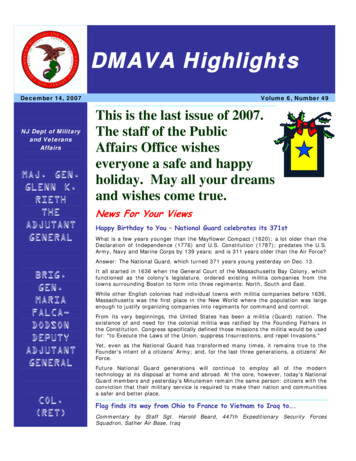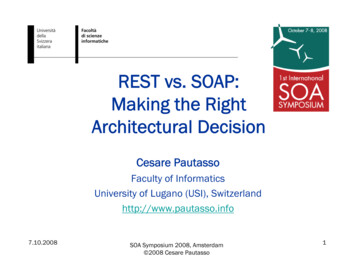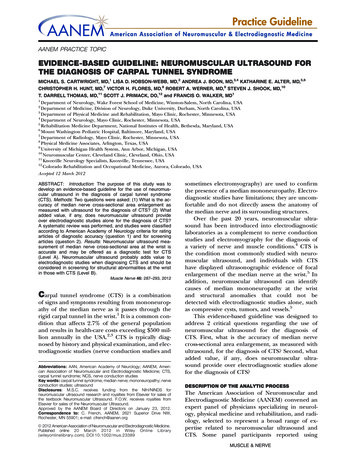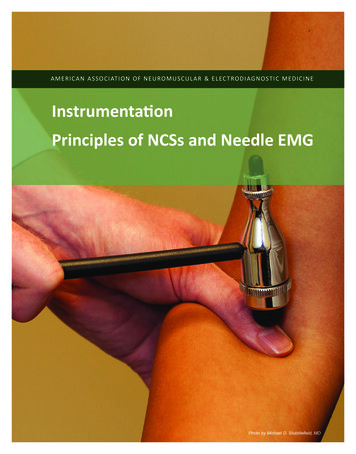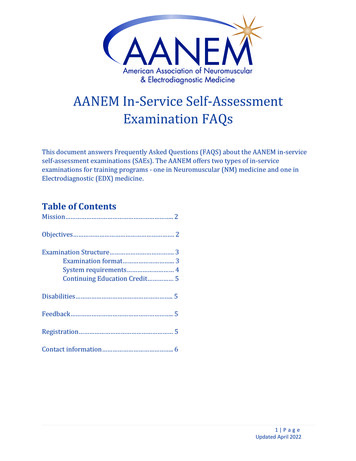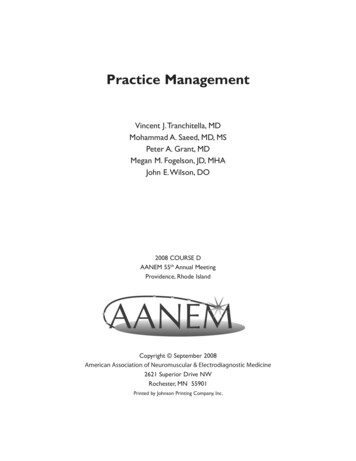
Transcription
Practice ManagementVincent J. Tranchitella, MDMohammad A. Saeed, MD, MSPeter A. Grant, MDMegan M. Fogelson, JD, MHAJohn E. Wilson, DO2008 COURSE DAANEM 55th Annual MeetingProvidence, Rhode IslandCopyright September 2008American Association of Neuromuscular & Electrodiagnostic Medicine2621 Superior Drive NWRochester, MN 55901Printed by Johnson Printing Company, Inc.
iiPractice ManagementFacultyVincent J. Tranchitella, MDPeter A. Grant, MDPrivate PracticeYork, PennsylvaniaPrivate PracticeMedford, OregonDr. Tranchitella received his medical degree from Pennsylvania StateUniversity College of Medicine in 1989 and completed his residency inphysical medicine and rehabilitation (PMR) at Baylor College of Medicinein 1993. He obtained board certification in PMR in 1994 and became aDiplomate of the American Board of Electrodiagnostic Medicine in 1998.He has been in private practice since 1993 as well as Outpatient MedicalDirector for Healthsouth in York, Pennsylvania. He is currently thechair of the American Association of Neuromuscular & ElectrodiagnosticMedicine (AANEM) Professional Practice Committee and a member ofthe AANEM Accreditation Committee.Dr. Grant received his medical degree from Texas Tech University Schoolof Medicine and received his residency training at Ohio State University,Department of Physical Medicine and Rehabilitation. He has been inprivate practice for 23 years and currently limits his practice to electrodiagnostic (EDX) medicine consultations. Dr. Grant has served onmany committees of the American Association of Neuromuscular &Electrodiagnostic Medicine (AANEM) and on the AANEM, Board ofDirectors. Currently he is Secretary/Treasurer of the AANEM; Chairmanof the EDX Laboratory Accreditation Committee, serves on the Marketingand Finance Committees, the PhD Task Force, and is the Oregon StateLiaison for the AANEM. Dr. Grant has lectured extensively in the areaof fraudulent and abusive EDX practices and how to identify and combatthem. He also has expertise in medical practice management and especially in developing and maintaining a successful EDX medicine practice.Mohammad A. Saeed, MD, MSClinical Associate ProfessorDepartment of Rehabilitation MedicineUniversity of WashingtonSeattle, WashingtonDr. Saeed received his specialty training in physical medicine and rehabilitation at the University of Washington in Seattle. Dr. Saeed is boardcertified with the American Board of Physical Medicine & Rehabilitation,as well as the American Board of Electrodiagnostic Medicine. Followingresidency, he served in the United States Army at Madigan Army MedicalCenter in Tacoma, Washington, and from 1981-1982 as Chief of thePhysical Medicine Service.For the past 26 years, he has been in private practice, now as senior partnerwith Electrodiagnosis and Rehabilitation Associates. He has served on theAmerican Association of Neuromuscular & Electrodiagnostic Medicine(AANEM) on the Education, Workshop, Training program, Program, andProfessional Practice Committees. He is also presently serving as Secretaryof Washington State Society of PMR. In 1005 Dr. Saeed was honored byreceiving the first AANEM Outstanding Advocate Award.Authors had nothing to disclose.Course Chair: Megan M. Fogelson, JD, MHAThe ideas and opinions expressed in this publication are solely those of the specific authors anddo not necessarily represent those of the AANEM.
iiiMegan M. Fogelson, JD, MHAJohn E. Wilson, DODirector of Health PolicyAmerican Association of Neuromuscular & Electrodiagnostic MedicineRochester, MinnesotaPrivate PracticeNeuroDiagnostic Associates of MarylandBaltimore, MarylandMs. Fogelson is the AANEM Director of Health Policy. She receivedher master’s degree in Healthcare Administration from the Universityof Minnesota, Carlson School of Business, and her law degree fromWilliam Mitchell College of Law. She is a member of the MinnesotaBar. Ms. Fogelson manages the AANEM’s advocacy initiates and the newElectrodiagnostic Laboratory Accreditation Program.Dr. Wilson is in his twelfth year of private practice. He earned his bachelor's degree in biology from Loyola College, Baltimore in 1988 and hismedical degree in 1992 from the Philadelphia College of OsteopathicMedicine. In 1996, he completed his residency in physical medicine andrehabilitation at the National Rehabilitation Hospital in Washington, DC.Dr. Wilson went on to pursue a fellowship in interventional non-operativespine at the Scoliosis and Spine Center, St. Joseph Hospital, Baltimore,MD.Dr. Wilson is an active member of the American Association ofNeuromuscular & Electrodiagnostic Medicine (AANEM) ProfessionalPractice Committee and he is board certified by the American Board ofElectrodiagnostic Medicine. He has served as an alternate on the CarrierAdvisory Committee, and has met with large payors in his state to discussEDX issues. He received the AANEM Outstanding Advocate Award in2007 for his efforts in advocating for quality electrodiagnosic medicine.
ivPractice ManagementAANEM Course ivPlease be aware that some of the medical devices or pharmaceuticals discussed in this handout may not be cleared by the FDAor cleared by the FDA for the specific use described by the authors and are “off-label” (i.e., a use not described on the product’slabel). “Off-label” devices or pharmaceuticals may be used if, in the judgement of the treating physician, such use is medically indicated to treat a patient’s condition. Information regarding the FDA clearance status of a particular device or pharmaceutical maybe obtained by reading the product’s package labeling, by contacting a sales representative or legal counsel of the manufacturerof the device or pharmaceutical, or by contacting the FDA at 1-800-638-2041.
vPractice ManagementContentsFacultyiiObjectivesvCourse CommitteeviBuilding Your Referral Base1Vincent J. Tranchitella, MDSuccessful Marketing Strategies for Electrodiagnostic and Neuromuscular Medicine5Mohammad A. Saeed, MD, MSHow to Create a Successful Team and Build Your Referal Base9Peter A. Grant, MDAdvocacy Overview15Megan M. Fogelson, JD, MHAPayor Advocacy23John E. Wilson, DOEDX Laboratory AccreditationPeter A. Grant, MDCME Activity and Faculty Evaluation61OBJECTIVES—After attendance at this session, participants will be able to list components necessary to build and maintain a successful EDXpractice, understand the three types of advocacy and the goals achievable by each. Attendees will also learn about the accreditation program.P R E R E Q U I S I T E — This course is designed as an educational opportunity for physicians.A C C R E D I TAT I O N S TAT E M E N T — The AANEM is accredited by the Accreditation Council for Continuing Medical Educationto provide continuing medical education (CME) for physicians.CM E C R E D I T —The AANEM is accredited by the ACCME to provide continuing medical education (CME) for physicians.The AANEM designates this educational activity for a maximum of 2 AMA PRA Category 1 Credit(s) TM. Each physician shouldonly claim credit commensurate with the extent of their participation in the activity. This event is an Accredited Group LearningActivity as defined by the Maintenance of Certification Program of The Royal College of Physicians and Surgeons of Canada.CME for this activity is available 9/08 - 9/11.
vi2007-2008 AANEM COURSE COMMITTEEAnthony E. Chiodo, MD, ChairAnn Arbor, MichiganShawn J. Bird, MDPhiladelphia, PennsylvaniaErick A. Grana, MDTampa, FloridaSimon Zimnowodzki, MDChicago, IllinoisKevin B. Boylan, MDJacksonville, FloridaThomas Y.C. Pang, MDChicago, IllinoisSasa Zivkovic, MDPittsburgh, PennsylvaniaGary L. Branch, DOOwosso, MichiganDavid Bryan Shuster, MDDayton, Ohio2007-2008 AANEM PRESIDENTPeter D. Donofrio, MDNashville, Tennessee
1Building Your Referral BaseVincent J. Tranchitella, MDPrivate PracticeYork, PennsylvaniaINTRODUCTIONBuilding a successful medical practice can be a daunting task. Thereare many factors that influence the survival of a medical practice.One important factor is patient referrals. A medical practice cannotsurvive without an adequate number of patient referrals. This is especially true of a practice specializing in electrodiagnostic medicine(EDX) consultations. Unfortunately, performing high-quality consultations does not guarantee a successful practice. There are significant competitive threats to an EDX consultation practice thatinclude general practitioners that use hand-held devices, roamingEDX laboratories, and surgical specialty practices that hire “inhouse” physiatrists or neurologists. Several specific ideas for increasing the number of EDX referrals to your practice will be identifiedto help you and your practice maintain a competitive edge.REFERRAL SOURCESIn order to increase your EDX referrals, it’s important to knowwhere the patients will originate. There are two main sourcesof referrals––physician referrals and patient referrals. Other lesscommon sources may include employers, contract physician organizations, and third party payors. In an EDX practice, unlike somegeneral practices, it is extremely unusual for patients to refer themselves or refer other patients for an EDX consultation. Therefore,almost all EDX referrals will come from other physicians. To increase the number of referrals, consider utilizing direct and indirectmarketing tools to current and potential referral sources.MARKETING PLANWhat is marketing? Marketing can be defined as determining whatconsumers want, and then offering services to meet those needs.Assume that your referral sources want high-quality, timely, reliable, and caring EDX consultations. To determine what will drivereferral sources to your office over that of a competitors, it is important to develop a marketing plan. There are four basic elements ofa marketing plan: research, positioning, product, and promotion.All four elements must be utilized.RESEARCHThe first element of a successful marketing plan is research.Research involves knowing where current patients are comingfrom, understanding the strengths and weaknesses of your practice,and identifying potential opportunities and possible threats.It should be easy to determine how new patients have been referredto your office. Improve patient registration sheets by adding questions such as: what doctor referred you to our practice, or what orwho encouraged you to choose our practice? (real source); may wesend a copy of a report to your family physician? (potential source).By knowing which physicians referred each patient, referral sourcescan be tracked and positive or negative trends can be identified.If a negative trend is discovered, it may be appropriate to call thephysician and ask how your service can be improved.Other research includes measuring your successes with current patients. Are they satisfied with the care you have provided? Would theyrecommend your practice to their friends? Would they recommendyou to the physician who referred them to your office? Knowing theanswers to these questions is important. Satisfaction surveys can helpidentify strengths and weaknesses of your current practice (i.e., prolonged waiting room times, the friendly or rude demeanor of officestaff members, the existence of a caring office atmosphere, the patientfeeling like their questions were answered, etc.).
2Building Your Referral BaseResearch also involves identifying potential opportunities and possible threats. Developing an association with a local occupationalmedicine practice, a large family practice, podiatrists or chiropractors, or a local hospital’s EDX clinic are all potential opportunities.An association with a large, self-insured company that has jobs requiring repetitive activities may also create business opportunities.It is important to evaluate the potential threats to your practice.How many physicians in your area perform EDX studies? Are thephysicians certified by the American Board of ElectrodiagnosticMedicine (ABEM)? Is their laboratory accredited? Do they have acaptive referral source (i.e., physiatrist or neurologist working foran orthopedic or neurosurgical group)? Keep a watchful eye for areabusinesses that are recruiting. Is your best orthopedic referral sourceadvertising for a physiatrist or neurologist to perform EDX studiesfor them? Contact the group and explain how you can meet theirneeds. If you are successful in identifying potential business opportunities and threats, it will be easier to make educated decisionsregarding the direction of your practice.POSITIONINGOnce you have completed your research, the second element ofthe marketing plan is positioning your practice. To appeal tocurrent and potential referral sources, take the time to becomeABEM certified, if you aren’t already. Additionally, makingcertain your EDX laboratory is accredited may prove to be important in the near future. It will strengthen your qualificationsover the competition. Establishing yourself as an expert in a nichearea, such as tarsal tunnel syndrome, Bell’s palsy, pelvic floor, orothers can also help separate you from the competition. Speakwith the providers who treat these conditions and educate themabout your potential role in the management of their patients.Develop an understanding of your state’s workers’ compensationlaws and position yourself accordingly. Finally, diversification canprevent vulnerability. One way to diversify a subspecialty practiceis by opening several different office locations, preferably in different communities.PRODUCTThe third element of the marketing plan, the product, is probablythe most important. Your goal should be to produce high-quality,timely, reliable, and caring EDX consultations. ABEM certification and an accredited laboratory are features suggestive of a highquality practice. It is important to understand that the perceptionof high quality is as significant as the actual quality. For patients,quality often translates into concern and responsiveness. Businessresearch shows that 70% of customers don’t return to a businesswhere the owner (i.e., physician), manager, or employees displayedan indifferent or negative attitude. Additionally, verbal communication accounts for only about 10% of the total message conveyed,while approximately 40% is conveyed by the tone of voice, and50% is communicated by body language. Be acutely aware of howyou and your staff are interacting with each and every patient thatcomes to your office.AANEM CourseThe EDX procedure is uncomfortable and can be quite painfulin an anxious patient. This experience can be significantly influenced by the overall office setting. Negative experiences will mostcertainly be relayed back to the referring physician. Strive to haveeach patient return to their referring physician with the impressionthat although the test wasn’t pleasant, at least the EDX physicianwas kind, compassionate, and informative. You want to be sure thatthey would recommend you to other patients.Quality issues also include patient convenience. Are you able tosee your patients in a timely fashion? Are office hours or locationsconvenient for most patients? Are weekend hours available? Do thepatients often have long office waits? Take control of scheduling tokeep appointments running on time.Timely reports are desired and appreciated by your referral sources.Reports can be sent out on the day of testing. The referring physician can have a copy faxed to their office. If the patient’s familyphysician is not the referring physician, permission can be obtained from the patient to send a copy of the report to the familyphysician. This also serves as indirect marketing to a potentialreferral source.The reports must not only be prompt, but they must be usefuland reliable. For guidelines on the recommended elements of ahigh-quality report, refer to the AANEM position statement onreporting the results of EDX testing (available on the AANEM’swebsite), or use one of the standard EDX text books to help youcreate a quality report. Your report should include a short discussion outlining your clinical and EDX impressions, as well as recommendations. This information is welcomed by most physicians. Itis important to know your referral sources. Some physicians simplywant test results and may not be impressed by your discussion.There may be more elaboration or discussion on a report for afamily physician than on one for a surgeon. If the study is normal,the report could address other possible etiologies for the patient’ssymptoms. Telephone follow-up on unusual or select cases, or thoserequiring prompt attention (i.e., lower limb spasticity or weaknessin cervical myelopathy) allows for personal contact with the referring physician.Caring is also translated by patients to be an element of quality.There are multiple ways to demonstrate to patients that you careabout them. One way to accomplish this is by discussing, in detail,the procedure about to be performed (informed consent). Askthe patient if they have any concerns or questions prior to theprocedure. Inform them the procedure can be discontinued if it isuntolerable. Let them know that they are in charge.Another aspect of providing quality care is to try and make theentire experience as comfortable as possible for the patient. Expectmost patients to arrive feeling a bit nervous or anxious. Avoid increasing their agitation with long wait times or by subjecting themto discourteous or rude staff members. Schedule the appointmenttimes at a reasonable pace, arrange a comfortable waiting roomenvironment with plants, soft or soothing color schemes, relaxingmusic and/or scents, and appropriate art work. Provide the patients
AANEM CoursePractice Managementwith appropriate reading material. When patients are placed in theexamination room, their anxiety will increase. Studies attemptingto examine factors that increase pain in EDX testing have demonstrated that predictors of higher levels of pain during an examination include a patient’s anxiety level, perception of his or her pain,and being of the female gender. One study has also shown thatcervical paraspinals, followed by lumbosacral paraspinals, and handintrinsics were the most painful EMG sites (in my personal experience, the foot and hand intrinsics appear to be the most painfulinsertion sites for the majority of patients).Enter the room with a smile and introduce yourself to the patient.Discuss the consultation, their symptoms, the examination, andthen explain the EDX procedure in detail prior to starting thetest. If this is their first EDX test, tell them that you will start bycollecting some information about their symptoms, followed by afocused physical examination, for example, in the area they havepain, weakness, or numbness. Describe the nature of the procedurein technical terms, but be honest with them. It is acceptable to tellpatients that the test may be uncomfortable, but that most patientsfind it tolerable. Assure them there should be no significant sideeffects. Ask if others have told them anything about an EDX examination. Sometimes they have heard “horror” stories. Be sure toaddress these fears.Utilize techniques to minimize the discomfort. During the nerveconduction study, gradually increase the stimulus until supramaximal stimulation has been achieved. During the needle electrodeexamination, pinch the skin and quickly advance the needlethrough the skin. Be sure to pull back into subcutaneous tissuewhen changing directions. Study recruitment by having the patientperform isometric contraction, and if alcohol is used, wait until itdries before inserting the needle. To help minimize a patient’s discomfort and anxiety, talk to the patient throughout the procedure.Ask about a patient’s hobbies or activities or talk with them abouttheir family. If the patient does not seem interested in conversation,explain the steps throughout the procedure. It is important to talk,no matter the subject. The bottom line is to take good care of yourpatients. They may remember the EDX as a negative or unpleasantexperience, but their perception of the care you provided can bepositive. You are in control of making a positive impression.It is appropriate to follow-up directly with the patient. After amedical consultation, it is acceptable to discuss the findings andimpressions with the patient. Discussing the results and implications regarding general treatment or further testing options isvery important to the patient. It gives them the impression thatyou are concerned and provided a specialized evaluation. Allowtime to answer questions. However, it is important to realize thatpatients should discuss specific future treatment options with theirtreating physician.Always ask a patient, before leaving the examination room, if theyhave any further questions. Offer to be available for any questionsthey may have after they leave the office. Additionally, ask them to3call you with updates on their condition. Patients rarely follow-up,but knowing that you cared enough to ask is appreciated by mostpatients. Even if you are no longer actively involved in a patient’scare, offering continued access to information makes a patient feelthat you care.PROMOTIONOnce you feel comfortable with the quality of your product, beginutilizing the fourth element of the marketing plan––promotingyour practice. Initially, send out a mass mailing to local physicians. Introduce yourself or discuss your focus on providing topquality EDX consultations. If possible, state an intention to offeran appointment within 24 to 48 hours of referral, with a reportto follow that same day. This is a great selling point for workers’compensation patients. Include a sample brochure explaining theEDX procedure that can be handed out to patients referred fortesting. Offer to provide, free of charge, a significant quantity ofthese brochures (stamped with your name and office number) tothe potential referring physician. Brochures can be self-designed,or obtained from AANEM on thier website at www.aanem.org.In any mass mailings, include a few business cards for their fileswith your contact information. Additionally, prescription padsmight be handed out to frequent referral sources to allow them tofill out brief consultation requests with their reason for referral orspecific consultation request. Your practice can also be promotedby a personal offer to give a grand rounds or lecture at a localhospital, to speak at a meeting with local employers who havesignificant repetitive jobs, or by writing a newsletter. Finally, if aletter introducing a new physician to your medical community isdelivered to your office, send a welcome letter back to introduceyourself and offer them assistance in making the transition tothe community.CONCLUSIONThe key to success is remembering that two satisfied customers areneeded, the patient and the physician who referred them. Utilizeany technique possible to make the referral process and subsequentreport easy and available to the referring physician. Make it a toppriority to provide quality care to the patient while minimizing anyprocedural discomfort and anxiety. These suggestions will be beneficial in increasing the number of referrals to your practice.RESOURCESPhysician’s News Digest, March 2008, pg. 11.Dumitru, Daniel: Electrodiagnostic Medicine, Hanley & Belfus, 1995, pp242, 387-412.AANEM Position Statement: Reporting the Results of Needle EMG andNerve Conduction Studies: An Educational Report. Available onlineat www.aanem.org
4AANEM Course
5Successful Marketing Strategies forElectrodiagnostic and NeuromuscularMedicineMohammad A Saeed, MD, MSElectrodiagnosis and Rehabilitation Associates of TacomaClinical Associate ProfessorRehabilitation MedicineUniversity of WashingtonSeattle, WashingtonWhat is Marketing?Merriam-Webster defines marketing as "the process of planningand executing the conception, pricing promotion, and distributionof ideas, goods, services, organizations, and events to create andmaintain relationships that will satisfy individual and organizational objectives.”Many people think that marketing is only about the advertisingand/or personal selling of goods and services. Advertising andselling are just two facets of many marketing strategies.Marketing is one area where most physicians probably do notreceive a great deal of training in medical school or in trainingprograms. Physicians that began their practices 20 or 30 yearsago initially enjoyed the “golden years” of private practice, thenendured the painful intrusion of managed care, and have survivedthe somewhat tumultuous aftermath. Some physicians are unhappywith their current positions. Many have reached a point where theyexpected to be able to “take it easy,” yet find themselves workingharder than ever. Others are concerned about a continued declinein reimbursements. With vast experience and an eagerness to work,practices and revenues continue to shrink while challenges continueto mount.2 Below are some suggestions that can help guide yourpractice along a path of success.Why Market Your Practice?Marketing your practice is important, whether you are just starting your medical career or would like to take your existing practice to the next stage of growth while offsetting the impact ofmanaged care.1The medical industry has changed tremendously over the pastyears. Electrodiagnostic and neuromuscular medicine is a referralpractice. Physicians must actively promote their services instead ofsimply waiting for patients. In planning for the future, it is necessary to take a proactive rather than a reactive approach. Years ago,physicians would not advertise in newspapers or in the telephonebook. Today, physicians must operate within this new competitiveenvironment.The advent of the Internet has resulted in significant changes inpatients’ expectations and knowledge base. When choosing theirmedical providers, patients examine whether a physician providestimely service, customer satisfaction, and quality care.Referring physicians and payors are also holding physicians tohigher standards. A well-planned and executed marketing plan isthe first step in staying ahead of competitors and meeting the needsof patients and referral sources. Marketing is a way to educate patients, referring physicians, and the community about the servicesyour practice has to offer.Many people confuse marketing with advertising. Both components are important, but differ in many ways. Marketing involvesthe development and implementation of a strategic marketing plan.The marketing strategy will outline the specific actions needed toreach the outcome goals desired.Advertising is an expensive and impersonal means of reachinga large audience. It can be purchased on radio, television, billboards, and in newspapers and magazines. Advertising can involvea direct mailing to a target audience. Some people may not like“advertising” and consider it to be flashy and unprofessional.
6Successful Marketing Strategies for Electrodiagnostic and Neuromuscular MedicineHowever, advertising is simply one component of a marketing plan.Some of the reasons to market your practice include gains in marketshare and an increase in revenue, increased patient volume, the opportunity to increase the number of physicians, and the ability toexpand into new areas such as health maintenance organizations orindependent medical examinations. All of these can help offset theimpact of managed care. Marketing can also help increase generalpublic and patient awareness of your practice or of any new officelocations that may be opening. Developing business relationships through marketing can be of great value in expanding yourreferral base.Physicians often depend on the same referral base they usedmany years ago. However, not all of those physicians are stillpracticing. Some have relocated, while others have retired.Some patients have switched to managed care plans, whichresults in business declines. Solo practices are particularly vulnerable, as some managed care plans will only contract withgroup practices.To have a successful practice, the referral base must grow. It isimportant to develop relationships with young physicians thatare entering the community. Seasoned physicians are needed tointroduce them to the community and for support.New primary care physicians need to know where to refer theirpatients for specialized care. They will gain confidence in a physician’s ability to treat patients from a personal and a clinical pointof view once the lines of communication are open and a relationship grows.Additionally, the medical staff offices at local hospitals can providestaff rosters. This is a good place to seek out new physicians in thearea. Prepare a list of the physicians that would benefit from yourservices and begin contacting them.Make a point to introduce yourself to each physician targeted.Invite them to a business lunch or another activity where you can‘market’ your services. Physicians are known to be extremely busyand often have little time. Consider offering to bring lunch totheir office. Furthermore, invite them to a local medical societymeeting where they can also network with other area physicians.Get to know them personally and find out about their personalinterests. If their hobbies include sports or boating, invite themto join you for a tennis match or a round of golf. If your officeis planning a company picnic, invite them to come and to bringtheir families.2Additionally, stay active with hospital activities and committeework. Grand rounds and involvement with committees can payoff in developing relationships with other physicians.Tap into your local media. Contact the editor of the health andmedicine section of a local newspaper and extend an invitation fora personal interview.AANEM CourseIn terms of print media, consider developing a folder of material tohighlight your practice. This is an ideal tool to bring to a marketing luncheon with other practices. The
Megan M. Fogelson, JD, MHA Director of Health Policy American Association of Neuromuscular & Electrodiagnostic Medicine Rochester, Minnesota Ms. Fogelson is the AANEM Director of Health Policy. She received her master's degree in Healthcare Administration from the University of Minnesota, Carlson School of Business, and her law degree from

